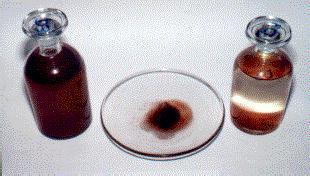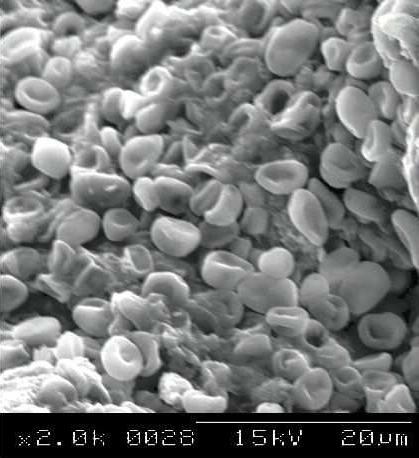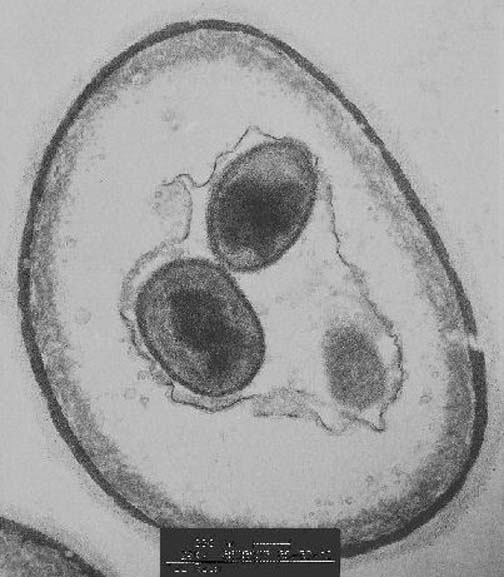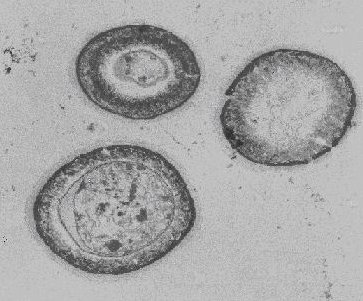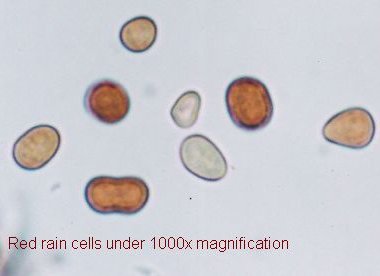|
|
|||
|
..
Photomicrograph of particles from red rain sample Red Rain in Kerala, India From 25 July to 23 September 2001, red rain sporadically fell on the southern Indian state of Kerala. Heavy downpours occurred in which the rain was coloured red, staining clothes with an appearance similar to that of blood. Yellow, green, and black rain was also reported. Coloured rain had been reported in Kerala in as early as 1896 and several times since then. It was initially announced that the rains were coloured by fallout from a hypothetical meteor burst, but a study commissioned by the Government of India found that the rains had been coloured by airborne spores from a locally prolific terrestrial alga. Other explanations were proposed but not until early 2006 did the coloured rains of Kerala gain widespread attention in the popular media. A controversial conjecture that the coloured particles were extraterrestrial cells was proposed by Godfrey Louis and Santhosh Kumar of the Mahatma Gandhi University in Kottayam. No information to support the extraterrestrial hypothesis has been published since 2006. - Wikipedia |
|||
| Cometary
panspermia explains
the red rain of Kerala
Authors: Godfrey Louis, A. Santhosh Kumar (Submitted on 5 Oct 2003) Abstract: Red coloured rain occurred in many places of Kerala in India during July to September 2001 due to the mixing of huge quantity of microscopic red cells in the rainwater. Considering its correlation with a meteor airbust event, this phenomenon raised an extraordinary question whether the cells are extraterrestrial. Here we show how the observed features of the red rain phenomenon can be explained by considering the fragmentation and atmospheric disintegration of a fragile cometary body that presumably contains a dense collection of red cells. Slow settling of cells in the stratosphere explains the continuation of the phenomenon for two months. The red cells under study appear to be the resting spores of an extremophilic microorganism. Possible presence of these cells in the interstellar clouds is speculated from its similarity in UV absorption with the 217.5 nm UV extinction feature of interstellar clouds. Comments: 20 pages, 5 figures,
paper to be submitted
to Nature
|
|||
|
..
Red rain collected in buckets Between July and September of 2001, a phenomenon occurred in India that, to this day, has not been positively explained. The ‘Red Rain of Kerala’ has become one of the most discussed anomalies of recent years and, for some, its occurrence proves that we are not alone in the universe. The red rain first fell on the Kottayam and Idukki districts of Kerala on July 25th, 2001 and the downpours were most intense during the first ten days, growing less frequent over the following eight weeks. Locals were baffled by the red staining they found on their clothes and linen and buckets, pails and bowls collected more of the coloured water. Some other hues were reported, but the scarlet tint was most prevalent. Strangely, the red rain fell in very localised areas, with normal rain falling only a few metres from where the coloured water was collected. According to early eyewitnesses, the first red rain was preceded by a thunderclap and a bright flash in the sky. This led some to conclude that the staining was caused by dust from a high altitude meteorite burst over the region. As the phenomenon diminished, Kerala’s red rain became just another mystery to file away. Indeed, a report from the Centre for Earth Science Studies (CESS) and the Tropical Botanical Garden and Research Institute (TBGRI) in Kerala concluded that the cause of the red rain were algal spores from local trees. The report determined that there was no volcanic, desert or meteoric dust in the rain and that no pollutants or gases had caused the odd colouring. What was not explained was why the rain fell in such localised areas, nor why the cells that were analysed contained high concentrations of aluminium and low amounts of phosphorous. Aluminium is not usually found in biological cells and phosphorous is normally found in much higher quantities. The mystery really exploded onto the world scene in April, 2006, when Dr Godfrey Louis and his research student, A. Santhosh Kumar, published a report in the Astrophysics and Space Science journal, suggesting that the red particles were microbial, extra-terrestrial organisms. They proposed that a meteorite exploded high over Kerala, releasing in excess of 50,000kg of the alien microbes over the region. Slowly, the alien cells drifted down over the followring two months, explaining the high concentrations at the beginning of the incident that diminished over time. Unfortunately, however, no meteoric or cometary dust has been found in the samples taken from Kerala. Tests on the cells by Louis’ team found that no DNA could be found, something unheard of in terrestrial biological organisms. Recent studies by Professor Chandra Wickramasinghe of Cardiff University have yielded positive results for DNA in the cells, but the mystery does not stop there.
Experiments in the laboratory have shown that the cells can reproduce in water heated to nearly 600?F (300?C). All known earthly microbes are killed when heated to only 250?F (130?C). So what do we have here? Are the cells found in the Kerala red rain terrestrial spores of a previously unknown type, that sometimes defy attempts to locate DNA in its structure, that can reproduce at temperatures that would kill any known microbe or bacteria, that contain high concentrations of aluminium and low levels of phosphorous (in direct oppositions to all earth-based life). Are the cells really only hardy algae spores that are common in Kerala, as the first official report suggested? Or is what fell on that Indian province five years ago the first definite proof that life exists in the depths of space and sometimes finds its way to Earth? It seems that the scientific community is divided on this one… © Steve Johnson - 2006
Small bottles like the ones shown
above can store a variety of liquids, from scientific water samples to
homemade essential oils. Finding the perfect essential oil bottles for a
specific formula can be tricky, but there is a large selection of essential oil bottles wholesale to choose from online. |
|||
Occurrence The coloured rain of Kerala began falling on 25 July 2001, in the districts of Kottayam and Idukki in the southern part of the state. Yellow, green, and black rain was also reported. Many more occurrences of the red rain were reported over the following ten days, and then with diminishing frequency until late September. According to locals, the first coloured rain was preceded by a loud thunderclap and flash of light, and followed by groves of trees shedding shrivelled grey "burnt" leaves. Shrivelled leaves and the disappearance and sudden formation of wells were also reported around the same time in the area. It typically fell over small areas, no more than a few square kilometres in size, and was sometimes so localised that normal rain could be falling just a few metres away from the red rain. Red rainfalls typically lasted less than 20 minutes. Each millilitre of rain water contained about 9 million red particles, and each litre of rainwater was contained approximately 100 milligrams of solids. Extrapolating these figures to the total amount of red rain estimated to have fallen, it was estimated 50,000 kilograms of red particles had fallen on Kerala. Description of the particles The brownish-red solid separated from the red rain consisted of about 90% round red particles and the balance consisted of protozoans and debris.[5] The particles in suspension in the rain water were responsible for the colour of the rain, which at times was as strongly coloured as blood. A small percentage of particles were white or had light yellow, bluish gray and green tints.[3] The particles were typically 4 to 10 µm across and spherical or oval. Louis's images with a scanning electron microscope showed the particles as having a depressed centre, suggestive of biological cell, especially red blood cells. At still higher magnification some particles showed internal structures. - Wikipedia
..
purportedly showing a detached inner capsule. Source: CCAB, Cardiff University |
|||
| Official Report
Initially the Centre for Earth Science Studies (CESS) had said that the cause of the red rain was an exploding meteor, which had dispersed about 1,000 kg (around one ton) of material. A few days later, when the red rain continued to fall, CESS retracted this. (Debris from a meteor would not have continued to fall in the same area; it would have been dispersed by winds.) CESS and the Tropical Botanical Garden and Research Institute (TBGRI) jointly issued a statement that the particles colouring the rainwater were some type of spore. Then in November of 2001, commissioned by the Government of India's Department of Science & Technology, the CESS and TBGRI released a report which concluded that: The colour was found to be due to the presence of a large amount of spores of a lichen-forming alga belonging to the genus Trentepohlia. Field verification showed that the region had plenty of lichens. Samples of lichen taken from Changanacherry, when cultured in an algal medium, also showed the presence of the same species of algae. Both samples (from rainwater and from trees) produced the same kind of algae, indicating that the spores seen in the rainwater could most probably have come from local sources. Although red or orange, Trentepohlia is a Chlorophyte green alga which can grow abundantly on tree bark or damp soil and rocks, but is also the photosynthetic symbiont or photobiont of many lichens, including some of those abundant on the trees in Changanacherry area. The report also stated that there was no dust of meteoric, volcanic, or desert origin present in the rainwater, and that the colour of the rainwater was not due to any dissolved gases or pollutants. The report concluded that heavy rains in Kerala in the weeks preceding the red rains could have caused the widespread growth of lichens, which had given rise to a large quantity of spores in the atmosphere. However, it could find no satisfactory explanation for the apparently extraordinary dispersal, nor for the uptake of the spores into clouds. It noted, for example, that prior to the first red rainfall there had been almost continuous rain for a period of eight hours. CESS responded ‘‘While the cause of the colour in the rainfall has been identified, finding the answers to these questions is a challenge.’’ Parts of the CESS/TBGRI report were
supported by Milton
Wainwright at Sheffield University, who, together
with Chandra Wickramasinghe,
has studied stratospheric spores. In March 2006 he
said the particles were
similar in appearance to spores of a rust fungus,
later saying that he
had confirmed their similarity to spores or algae,
and found no evidence
to suggest that the rain contained dust, sand, fat
globules, or blood.
-
Wikipedia
Frames (1) and (2) show the microscopic spores that colored the Keralan rains; (3) rain samples with (a) spores settled to the bottom, (b) rainwater evaporated, and (c) spores suspended in the rainwater; (4) Trentepohlia algae grown from the spores. [5] |
|||
| Extraterrestrial
Hypothesis
In 2003 Louis and Kumar, physicists at Mahatma Gandhi University in Kottayam, Kerala, posted an article entitled “Cometary panspermia explains the red rain of Kerala”[21] in the on-line, non-peer reviewed arXiv web site. While the CESS report said there was no apparent relationship between the loud sound (possibly a sonic boom) and flash of light which preceded the red rain, to Louis and Kumar it was a key piece of evidence. They proposed that a meteor (from a comet containing the red particles) caused the sound and flash and when it disintegrated over Kerala it released the red particles which slowly fell to the ground. Their work indicated that the particles were of biological origin (consistent with the CESS report), not inorganic material and they invoked the panspermia hypothesis to explain the presence of cells in a supposed fall of meteoric material. Additionally, using ethidium bromide they were unable to detect DNA or RNA in the particles. Two months later they posted another paper on the same site entitled “New biology of red rain extremophiles prove cometary panspermia” in which they reported that The microorganism isolated from the red rain of Kerala shows very extraordinary characteristics like ability to grow optimally at 300°C (572°F) and the capacity to metabolize a wide range of organic and inorganic materials. These claims and data have yet to be reported in any peer reviewed publication. In 2006 they published a paper in Astrophysics and Space Science entitled "The red rain phenomenon of Kerala and its possible extraterrestrial origin" which reiterated their hypothesis that the red rain was biological matter from an extraterrestrial source but made no mention of their claims to having induced the cells to grow. One of their conclusions was: If the red rain particles are biological cells and are of cometary origin, then this phenomena can be a case of cometary panspermia. Panspermia is the hypothesis that
life on Earth was
carried here from elsewhere in the universe. Fred
Hoyle and Chandra Wickramasinghe
have been among the proponents of the theory, but it
has not been accepted
by most mainstream scientists. The paper in
Astrophysics and Space Science
prompted numerous articles in the popular media.
Controversy A quotation attributed to Carl Sagan that "Extraordinary claims require extraordinary evidence" is often used regarding the claims of alien life. Samples of the red particles were also sent for analysis to Milton Wainwright at Sheffield University and Chandra Wickramasinghe at Cardiff University. Wickramasinghe has reported on December, 2006 that “work in progress has yielded positive for DNA”, but the results have not yet been confirmed. The absence of DNA is key to Louis and Kumar's hypothesis that the cells were of extraterrestrial origins. Wainwright is quoted as saying: “There appears to be an increasing tendency among scientists to come up with wild explanations when asked by the press to comment on unusual, novel phenomena. A good example is provided by comments about the recent Indian red rain phenomenon." A correction was printed in The Observer regarding Dr. Wainwright's comment that the red rain lacked DNA. Dr. Wainwright asked in the correction to make clear that he currently had no view on whether the samples contained genetic material or not, and that it was physicist Godfrey Louis who held that view. The controversial research of Louis et al. is the only evidence suggesting that these organisms are of extraterrestrial origin. Sainudeen Pattazh came to the conclusion that, "Regarding red rain, there was an argument that it was alien presence. But that’s just like science fiction. During 2001-02, [a] peculiar geological situation was prevailing in Kerala like caving in of wells and landslides.” A study has been published showing a correlation between historic reports of colored rains and of meteors.[29] In an interview[30] The author of the paper, Patrick McCafferty, said: "Sixty of these events (coloured rain), or 36 percent, “were linked to meteoritic or cometary activity,” he went on. But not always strongly. Sometimes, “the fall of red rain seems to have occurred after an airburst,” as from a meteor exploding in air; other times the odd rainfall “is merely recorded in the same year as a stone-fall or the appearance of a comet.” - Wikipedia Related Links |
|||
..
|
|||
References
External links
|
|||
| FAIR USE NOTICE: This page contains copyrighted material the use of which has not been specifically authorized by the copyright owner. Pegasus Research Consortium distributes this material without profit to those who have expressed a prior interest in receiving the included information for research and educational purposes. We believe this constitutes a fair use of any such copyrighted material as provided for in 17 U.S.C § 107. If you wish to use copyrighted material from this site for purposes of your own that go beyond fair use, you must obtain permission from the copyright owner. | |||
|
|


